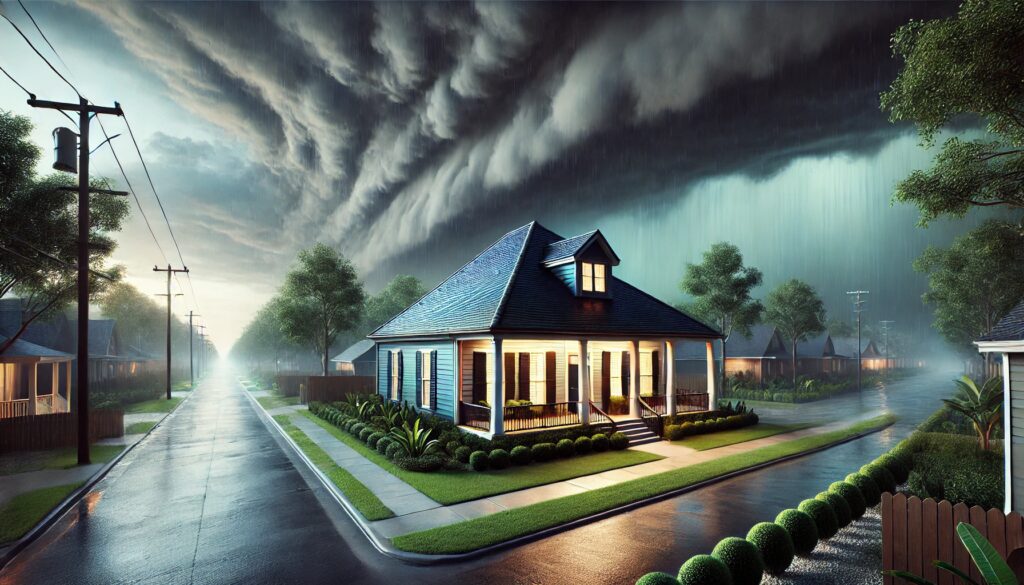Hurricanes are a natural part of life in Louisiana, but being prepared can make all the difference in protecting what matters most. Since 2000, Louisiana has weathered over 40 tropical storms and hurricanes—some causing power outages, flooding, and severe damage to homes and businesses. Hurricanes like Ida showed how quickly daily life can be disrupted. That’s why it’s so important to take simple steps now to strengthen your property and stay ready. With the right preparation, you can face any storm with greater peace of mind.
In this guide, we’ll outline five practical and effective tips for storm-proofing your property. From securing your roof to maintaining drainage systems, these measures will help ensure your property withstands Louisiana’s challenging weather.
1. Secure Your Roof First: Vital Step to Storm-Proof Your Property in Louisiana
Your roof is your property’s first line of defense during a storm. Ensure it’s ready to handle Louisiana’s relentless winds and heavy rains by:
- Inspecting for damage:
- Loose or missing shingles
- Cracked tiles
- Signs of wear or gaps
- Reinforcing with hurricane straps:
- These metal connectors secure the roof to the frame, reducing the risk of roof lift during high winds.
- Waterproofing critical areas:
- Apply sealants around vents, chimneys, and skylights to prevent water infiltration.
Did you know? According to FEMA, hurricane straps can reduce roof damage by up to 80% during a storm. Investing in these upgrades now can save thousands in repairs later.
2. Strengthen Windows, Doors, and Garage
Windows, doors, and garage doors are some of the most vulnerable points in any structure. Strengthen these areas to prevent wind and debris from causing catastrophic damage.
- Upgrade your windows:
- Install storm shutters or impact-resistant glass.
- Use plywood as a temporary fix, but prioritize permanent solutions.
- Reinforce garage doors:
- Add horizontal braces.
- Upgrade to hurricane-rated doors to prevent collapse under pressure.
- Install weatherstripping:
- Seal gaps around doors to block wind-driven rain and minimize water damage.
Quick Tip: A compromised garage door can allow wind into your building, increasing internal pressure and lifting the roof. Don’t overlook this critical area.
3. Clear the Yard
Your yard can become a source of dangerous projectiles during a storm. Protect your property by addressing potential hazards:
- Trim overhanging branches: Prevent them from damaging your roof or windows.
- Remove dead or unstable trees: These are more likely to topple during high winds.
- Secure outdoor items: Bring in furniture, grills, and potted plants, or secure them in a shed.
Think about this: Even small garden tools can become high-speed projectiles, causing significant damage during a hurricane. Clearing your yard is an easy, effective way to storm-proof your property.
4. Fortify the Foundation
Flooding is one of the most destructive consequences of hurricanes, and your foundation plays a critical role in minimizing water damage.
- Seal foundation cracks: Use water-resistant materials to prevent seepage.
- Install a sump pump: Quickly remove accumulating water from basements or low-lying areas.
- Elevate utilities: Raise HVAC systems, electrical panels, and appliances above potential flood levels.
For properties in flood-prone areas, consider long-term solutions like elevating the entire property. While costly, this investment offers unmatched protection and may even lower insurance premiums.
5. Maintain the Drainage System
An effective drainage system can prevent water from pooling around your property, which can weaken the foundation and lead to costly repairs.
- Clean gutters and downspouts: Remove leaves and debris regularly to prevent clogs.
- Ensure proper grading: The land around your property should slope away from the structure to direct water elsewhere.
- Install trench drains: These systems are ideal for managing heavy runoff in areas prone to pooling.
Fact: Poor drainage is one of the leading causes of water-related structural damage during hurricanes. Regular maintenance ensures your system is ready for the next storm.
Take Action Today
When was the last time you inspected your roof or checked your drainage system? Is your property truly ready for the next extreme weather event?
Secure your home or business before the next storm hits. Contact Terry Honore Construction today for a customized storm-proofing solution. From roof reinforcements to foundation upgrades, we’ll help you protect what matters most. Don’t wait until it’s too late—act now!



